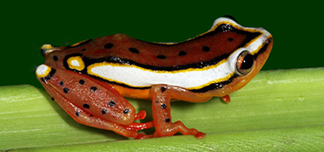Phrynobatrachus perpalmatus Boulenger, 1898
This species named includes the Latin 'palmatus' meaning shaped like a hand, referring to the extensive webbing on the feet.
This puddle frog species is easily distinguied by its almost fully webbed toes, which is uncommon for its small size. Members of this genus are identified by the presence of a midtarsal tubercle, elongate inner metatarsal tubercle, and outer metatarsal tubercle.
The IUCN Red List (2010) categorizes this species as Least Concern in view of its wide distribution, its tolerance of a broad range of habitats, its presumed large population, and because it is unlikely to be declining fast enough to qualify for listing in a more threatened category (Pickersgill and Channing, 2004).
It occurs in a number of protected areas (Pickersgill and Channing, 2004).
It is probably an adaptable species that is only facing localized threats (Pickersgill and Channing, 2004).
Populations of this species are believed to be stable (Pickersgill and Channing, 2004).
According to Pickersgill (2007), these frogs were seen at the edges of rice paddies where "the water was so hot from thesun you could've probably brewed a cup of tea from it." Frogs would jump in and out of water from the surrounding vegetation.
Tongue has a conical median papilla. Habit is ranoid. Head is small; snout is short, subacuminate and without canthus. Interorbital space is convex and slightly narrower than the upper eyelid (Boulenger, 1898). The eye diameter is smiliar to the snout length, and nostrils are equidistant between the eye and snout tip (Pickersgill, 2007). The tympanum is visible; Channing and Howell (2006) report that the tympanum is two-thirds the size of the eye diameter, while Pickersgill (2007) reports that it is 40-50%. The first finger is shorter than the second. The toes are almost completely webbed with 1-1.5 phalanges on toe IV are free of webbing and 0-0.5 phalanx of toes III and V are free of web (Channing and Howell, 2006; Pickersgill, 2007). Boulenger (1898) reports that digital tips are slightly swollen, but small discs have been reported to be on both fingers and toes (Channing and Howell, 2006; Pickersgill, 2007). Subarticular tubercles are small. An inner metatarsal tubercle, outer metatarsal tubercle, and tarsal tubercle are present. According to Boulenger (1898) the tibio-tarsal articulation reaches the eye, and the tarso-metatarsal articulation reaches beyond the tip of the snout, but Pickersgill (2007) states that the tibio-tarsal articulation can sometimes fall short of the eye. The skin is feebly warty above. No femoral glands are present in the male, and the throat of males is unpigmented and without distinct folds (Channing and Howell, 2006).
Dorsum is brown with small, dark spots. A dark, light-edged streak is on each side from the eye to the groin, involving the tympanum. A dark cross-bar is present the thigh and tibia. The hinder side of the thighs is white with a wavy, blackish band. Venter is white. Some brown dots are on the throat. Two brown streaks or a series of spots are present on the lower surface of the thighs (Boulenger, 1898). A pale band is present below the vent, running from knee to knee with a second band interrupted at the vent (Channing and Howell, 2006). Dark speckling is present under the throat forms gular patches in females, and the throat in males is generally sprinkled with melanophores (Pickersgill, 2007).
Channing and Howell (2006) report that males are up to 25 mm and females up to 29 mm in length. The holotype specimen (sex not noted) is 22 mm in length (Boulenger, 1898).
This species is known to eat earthworms, snails, ants, beetles, spiders, waterbugs, bugs, dragonfly larvae, and fly larvae and is preyed upon by the olive sand snake Psammophis sibilans and the savanna vine snake Thelotornis capensis (Channing and Howell, 2006).
This species ranges from the Nile Valley of central and southern Sudan, south through the Democratic Republic of Congo to western Tanzania, Zambia, Malawi, northern Mozambique (Pickersgill and Channing, 2004).
It lives in humid savannah, grassland, and rainforest and degraded former forest (farm bush) at medium altitudes in permanently wet sites. It is believed to be able to survive in agricultural land in wet areas. It is particularly associated with flooded grassland, interspersed with reeds, where it presumably breeds (Pickersgill and Channing, 2004).
Although it is patchy in its distribution, at suitable locations populations tend to be large, and it can be locally very abundant (Pickersgill and Channing, 2004).
According the Channing and Howell (2006), males call at night ofrom flooded grasslands; the call was referred to as a "metallic ticking." Pickersgill (2007) describes the call as "a very coarse rasping croak."
